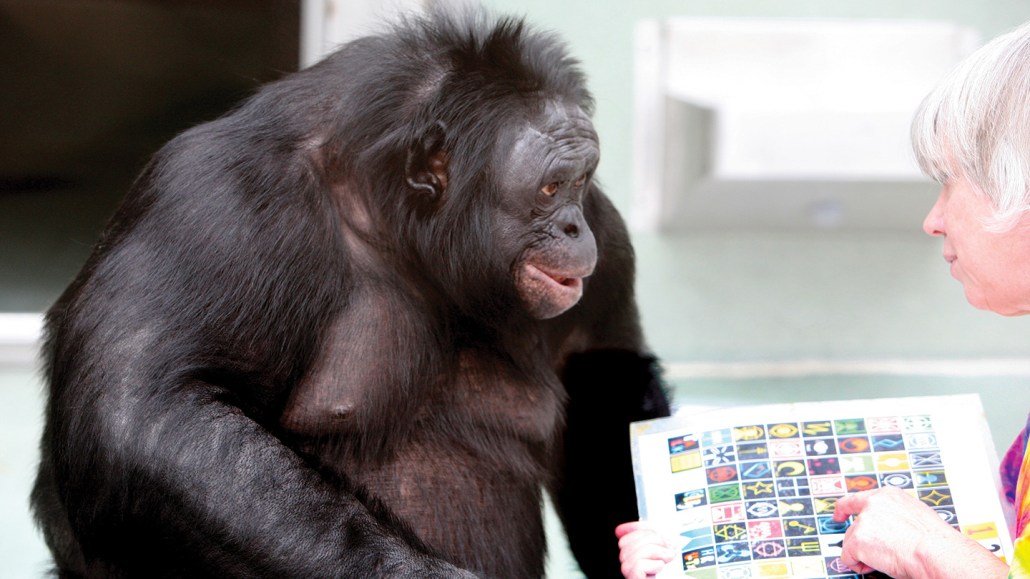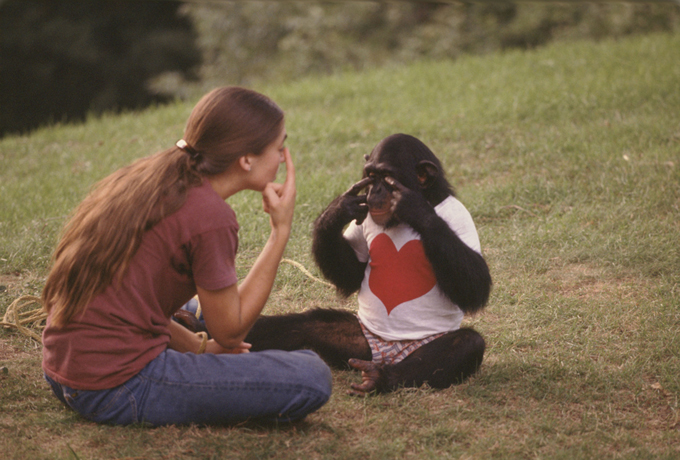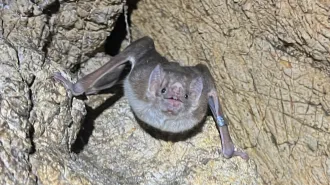A ‘talking’ ape’s death signals the end of an era
Kanzi the bonobo, who understood spoken English and could communicate symbolically, died this year

By Erin Wayman
Managing Editor, Print and Longform

Kanzi the bonobo, shown here in 2006 with psychologist Sue Savage-Rumbaugh, used symbols on a board to communicate with humans.
WILLIAM H. CALVIN, PH.D./WIKIMEDIA COMMONS (CC BY-SA 4.0)
Barbara J. King remembers the first time she met Kanzi the bonobo. It was the late 1990s, and the ape was living in a research center in Georgia. King walked in and told Kanzi she had a present. A small, round object created a visible outline in the front pocket of her jeans. Kanzi picked up a board checkered with colorful symbols and pointed to the one meaning “egg” and then to “question.” An egg?
No, not an egg. A ball. But “he asked an on-point question, and even an extremely simple conversation was just amazing,” says King, a biological anthropologist at William & Mary in Williamsburg, Va.
Born in 1980, Kanzi began learning to communicate with symbols as an infant. He ultimately mastered more than 300 symbols, combined them in novel ways and understood spoken English.
Kanzi was arguably the most accomplished among a cohort of “talking” apes that scientists intensely studied to understand the origins of language and to probe the ape mind. He was also the last of his kind. In March, Kanzi died.
“It’s not just Kanzi that is gone; it’s this whole field of inquiry,” says comparative psychologist Heidi Lyn of the University of South Alabama in Mobile. Lyn had worked with Kanzi on and off for 30 years.
Kanzi’s death offers an opportunity to reflect on what decades of ape-language experiments taught us — and at what cost.
A history of ape-language experiments
Language — communication marked by using symbols, grammar and syntax — has long been considered among the abilities that make humans unique. And when it comes to delineating the exact boundary separating us from other animals, scientists often turn to our closest living relatives, the great apes.
In the 1940s, psychologists tried raising a baby chimp named Viki at home as a human. After seven years of speaking lessons, she could utter only four words: mama, papa, cup and up. Eventually, scientists determined that chimpanzee anatomy doesn’t allow for speech, although some recent research questions that conclusion.
In the 1960s, researchers took a different approach, one suggested as early as the 17th century: Teach apes sign language.
In one famous case, psychologists Allen and Beatrix Gardner brought Washoe — a wild chimp who had been captured in Africa for NASA but never became a chimponaut — to the University of Nevada, Reno. Researchers shaped Washoe’s hands to teach her signs, and she came to use over 100 of them by age 4. The experiment was apparently so successful that Washoe later taught her son sign language.
In the 1970s, sign language experiments expanded to other types of apes, including Koko the gorilla and Chantek the orangutan.
Skepticism also crept in. Psychologist Herbert Terrace of Columbia University concluded that his study subject, Nim Chimpsky, a chimp named for linguist Noam Chomsky, failed to pick up language. Nim simply learned to produce signs to get food and other rewards. It was like a dog associating commands with a treat. Nim’s teachers, Terrace said, also unintentionally cued the chimp to get their desired responses.

Once again researchers switched tactics. At Georgia State University, psychologists developed a system of visual symbols that each represented a word or phrase. These “lexigrams” were abstract and thus not a clue to what the symbol meant. Go, for example, was a triangle with squiggly lines above it.
Researcher Sue Savage-Rumbaugh tried teaching the system to a bonobo named Matata. She didn’t catch on, but her adoptive son, Kanzi, who was present at her lessons, did. And that was a big deal.
The work “was incredibly important for clarifying the nature of language development,” King says. Kanzi wasn’t taught language — he absorbed it the way a human infant does.
Work with Kanzi and other “talking” apes showed that our simian relatives do have some capacity for language, and caused scientists to rethink human uniqueness, Lyn says.
Of course, there are differences. In Kanzi’s case, “there seems to be a lot more imperative usage, like he just want[ed] things,” says evolutionary anthropologist Simon Townsend of the University of Zurich. His conversations may have been more transactional than our own. “Much of our communication is very much declarative,” Townsend says, “with this prosocial drive to inform other individuals about things in the world.”
Still, these experiments demonstrated that apes have complex interior lives, King says. “The ability for people to have a direct conversation with an ape who was expressing that interiority was really mind-blowing.”
Studying apes and language today
But that recognition may have doomed ape-language studies. In recent decades, scientists have questioned whether it’s ethical to conduct experiments on these intelligent, highly social creatures. What happens when a study ends or loses funding? What happens if the ape is no longer around familiar faces or has no one to “talk” to?
After Terrace’s study, Nim Chimpsky bounced around biomedical labs before ending up at an animal sanctuary in Texas, where he died of a heart attack at age 26 — young for an animal that can live 40 to 45 years in the wild.
In 2012, staff at the Great Ape Trust in Iowa, where Kanzi spent his later years, raised concerns about ape health, safety and injuries at the research center. Though cleared in an internal investigation, Savage-Rumbaugh, executive director at the time, ultimately parted ways with the facility, which got new management and a new name, the Ape Initiative.
“In retrospect, I think there was absolutely no intention to harm these apes at all, but I do think they were harmed,” King says. “These apes were asked to transition from their world to a weird kind of mash-up of their world/our world…. Do we have the right to do that to another being?”
And so, ape-language research has evolved. Today, scientists hike into the wild to study natural ape communication, looking to see what aspects of language are present. Townsend and colleagues, for example, recently compiled a “lexicon” of bonobo calls, discovering that the apes combine calls in complex ways. Some calls modify other calls.
It might be a stretch to call that true syntax, but it’s another linguistic feat once thought to be unique to humans.







